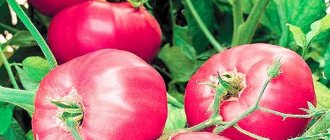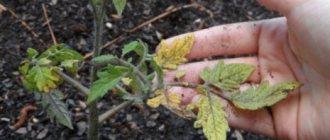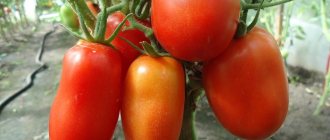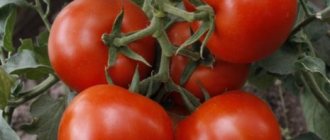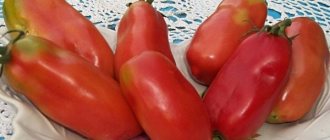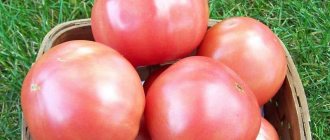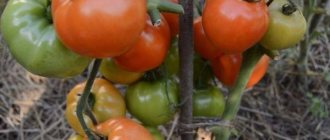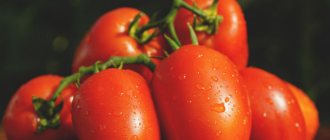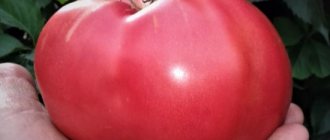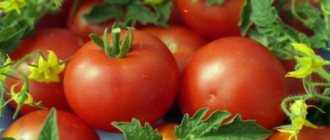The tomato variety Zhorik-obzhorik has a number of advantages - it is a compact, unpretentious plant that bears fruit best in open ground, is resistant to late blight and produces tasty fruits.
| Height | Landing location | Ripening time | Fruit color | Fruit size | Origin | Fruit shape |
| short | Open ground | Early ripening | Reds | Average | Variety | Round |
Why did the tomato gain popularity?
The plant is resistant to temperature fluctuations. Forms ovaries in hot and cool weather. The beds are compact. Some gardeners use it to compact tall tomato plantings.
- It is recommended to plant in open ground;
- determinate bush (grows up to 0.45 m);
- early ripening (from loops to first sample 95 days);
- no shaping, tying or pinching is required.
The seedlings do not stretch. Zhorik the glutton “runs away” from late blight. Gardeners note the resistance of tomatoes to root and blossom end rot. Actively forms ovaries in hot weather. Tolerates lack of moisture in the soil.
"Glutton"
Classic tomatoes for a jar. But when these tomatoes are taken out of the jar, everyone unanimously agrees that this tomato is the best.
A universal purpose tomato, having begun to bestow its fruits early, requires timely garter from you. Round, dense, fleshy fruits “sit” extremely tightly on the tomato plant and it simply breaks under the weight of its harvest.
Tomatoes weigh an average of 100 g, but their taste is not just good, but excellent, and by planting just a few bushes, the family will be fully supplied with a seasoning product for the winter.
Advantages of tomato:
- productivity;
- excellent taste;
- versatility.
There is plenty to choose from. Having considered the varieties, you can try to grow them and get real pleasure from the yield and taste.
source
varietal tomato seeds Obzhora
Ukraine
Order form for bulk purchases of seeds
Tomato "Glutton". Original, early (80-95 days), low-growing variety, super productive - the fruits literally cover the bush, the tomatoes are very decorative - red cream with a spout weighing up to 70 grams. The taste is excellent, sweet with a slight sourness. Tomatoes are ideal for whole fruit canning. The variety is quite lightweight and easy to transport. Disease resistance is good. It responds well to fertilizing with complex fertilizers.
Economy package weighing 20 seeds
Wholesale and retail price
You can plant tomatoes in their original place no earlier than after 2-3 years. When growing tomatoes, do not use fresh manure, otherwise the plants will become fattened: the shoots will begin to grow rapidly, very large leaves will appear, the stems will thicken, and the fruits will set poorly and grow slowly.
Some gardeners break off leaves on plants to increase yield. There is no need to get carried away with this technique, especially when growing tomatoes in a greenhouse or greenhouse. The leaves provide nutrients to the fruit, so during plant growth, try to remove only diseased and yellow foliage. When the fruits on the first lower cluster are completely filled, that is, they reach the size characteristic of this variety, the leaves under the cluster can be removed.
So gradually, as the tomatoes ripen, remove the leaves under each ripe cluster, but no more than 2-3 leaves per week from one plant. In addition, do not forget to temporarily remove the stepsons, otherwise you will lose part of the harvest. If the weather is cloudy during flowering, the fruits do not set well. This is because the pollen becomes sticky and incapable of pollination.
For better fruit set, spray the plants with a 0.02 percent solution of boric acid (2 g per 10 liters of water), using this amount per 100 square meters. m landings. If the weather does not improve, repeat spraying after 2-3 days.
Water the tomatoes rarely but generously. They love hilling and regular loosening of the soil between the rows: without this, the roots cannot actively work and deliver food and water for growth, plant development and fruit formation.
When growing tomatoes in a greenhouse, remember that temperatures above 32 degrees are detrimental to them. From the heat, leaves begin to curl, flowers and ovaries fall off. Therefore, monitor the air temperature in the greenhouse and ventilate it if necessary.
Light, highly fertile soils are suitable for cultivation. Good predecessors are cucumbers, cabbage, legumes, onions, carrots. Seeds for seedlings are sown at the end of March - beginning of April to a depth of 2-3 cm. Before sowing, the seeds are treated in potassium permanganate and washed with clean water. Picking - in the phase of 1-2 true leaves.
Seedlings are fed 2-3 times with complete fertilizer. 7-10 days before planting, seedlings begin to harden. Seedlings are planted in open ground at the age of 55-70 days, when the threat of frost has passed (for the Non-Black Earth zone - June 5-10), and when using temporary film shelters - a little earlier (May 15-20). Planting pattern 70x30 - 40 cm.
source
September 22nd. Tomato Glutton.
So the summer has flown by. The harvest has ended, and therefore we draw conclusions based on the harvest received.
March 13. Sowing.
March 19. Shoots.
March 25. The end result of sowing seeds.
The germination percentage was 85.
30th of March. Picking.
For further study, I picked 4 sprouts and gave the rest to a friend.
April 21. Transplantation into a greenhouse.
May 30. Freezing -6 degrees.
June 14. First flowers.
June 23. The first ovaries.
Based on this, I conclude: fruiting began after 101 days (according to the description, 95-105 days). The first inflorescences were formed above the 8th leaf, and the subsequent ones after 1 leaf. The height of the bushes is within 70 cm / according to the description 90 - 130 cm /
26 July. Beginning of fruit ripening.
August 1. Tasting.
The tomatoes taste juicy, tasty, with a pronounced tomato taste. For our family tastes, we really liked them. A very convenient variety - both for fresh consumption and canning.
I am calculating the yield.
In my greenhouse, 3 bushes were placed on an area of 80 x 120 cm = 0.96 sq.m (about 1 sq.m.)
The total harvest was 11 kg 250 g.
Thus, the yield is 11 kg 250 g (the manufacturer stated 9.5-10.3 kg/sq.m).
But it is also proposed to plant 4 or 5 plants per 1 sq.m., in my opinion, this is absolutely not necessary.
I consider this variety to be very indicative for my greenhouse this season in almost all respects. The only negative for me is that the greenhouse is designed for tall tomatoes. I don’t grow tomatoes in open ground.
I suggest that all gardeners who grow tomatoes in open ground or in tunnels try this variety. And I would like to express my gratitude to the agricultural sector for the successfully bred variety.
source
What makes a tomato happy?
Aelita breeders specialize in creating plants for regions with unstable weather. Zhorik-obzhorik is a representative of the variety for open ground.
The height of the tomatoes allows them to cover the plantings during heavy rainfall or sudden cold snaps. Gardeners can follow the rules of crop rotation on the beds. These measures ensure a good harvest.
- slight ribbing at the stalk;
- the berry is spherical, flattened at the top;
- the fruit is smooth, shiny, light red in color;
- weight up to 150 g;
- the skin is dense;
- the taste is rich, sour;
- the pulp is dense, juicy;
- seeds are small;
- the skin is dense;
- yield 5 kg/m².
Zhorik the glutton clings tightly to the bushes. The fruits do not crack when canned. Ripens in one or two waves. Green tomatoes ripen in the dark. Tomatoes retain marketability during transportation.
Gardeners eat the first berries fresh. The remains are processed: they produce juice, paste, ketchup, salt, and marinate whole.
How to get a good harvest?
Proper choice of variety is part of success. To obtain the desired harvest, it is recommended to follow the growing rules.
- check your own seeds for germination and disinfect;
- material from reputable manufacturers has passed soil control (ready for sowing);
- you should start growing seedlings 40–60 days before planting in a permanent place (the time varies in different regions);
- until germination, maintain a temperature of 23–25 degrees;
- after the loops appear, reduce to 18 degrees;
- harden and ventilate seedlings;
- water moderately;
- nitrogen fertilizers must be applied to the beds in the fall;
- lay the mineral complex in the spring;
- bury the seedlings when planting;
- The bushes require shading for the first 3–4 days;
- It is recommended to mulch the soil;
- plant densely: 5–6 bushes/m²;
- loosen the soil regularly;
- water in the morning.
Sowing seeds
You need to pour soil into boxes or other suitable containers. If the soil is taken from the garden, it must first be baked in the oven to kill viruses and fungi. Then you need to add mineral fertilizers there. Peat and river sand are good additives. The seeds are distributed in rows over the surface of the ground no deeper than 1 cm. There is no need to water the soil, it will be enough to moisten it a little. After sowing the seeds, the boxes are covered with film or glass and put away in a warm, sunny place. For rapid germination, regular watering and ventilation must be provided.
What do gardeners say?
Gardeners on forums talk about the Zhorik-glutton tomato. The variety attracts with its ripening period and unpretentiousness. The height of the bushes and the density of plantings make care easier. A good harvest is easy to obtain.
But the taste is inferior to salad tomatoes. Canned tomatoes remain tough and bland. The value of Zhorik the Glutton is to provide summer residents with early fruits.
The tomato variety Zhorik-obzhorik has a number of advantages - it is a compact, unpretentious plant that bears fruit best in open ground, is resistant to late blight and produces tasty fruits.
| Height | Landing location | Ripening time | Fruit color | Fruit size | Origin | Fruit shape |
| short | Open ground | Early ripening | Reds | Average | Variety | Round |
Description and characteristics of the variety
Tomato Zhorik-obzhorik is a determinate bush. Its height is 45-50 cm, after the development of several fruit clusters it stops growing.
The fruits ripen early - already 95 days after seed germination. They have a rounded shape, noticeable ribbing and a slightly flattened top. The skin color is red, the weight of tomatoes from the lower branches reaches 150 grams, the upper ones are smaller - usually 100 grams. The pulp is sweet with noticeable sourness, meaty and juicy. The variety is suitable for preparing various dishes, juices and pastes, adding to salads, whole canning and pickling.
On the way to your dream: to eat a tomato from the bush!
It seemed that “boss, everything is gone” even at the seedling stage.
I’m on top of you with tomatoes and this is only my second year growing them. Moreover, the first one was not very successful due to the choice of varieties. I seem to be prepared for spring 2021, but... My tomatoes are next to basil
From seedlings to fruits
I soaked seeds of four varieties in HB-101 solution on March 12th.
Within three days, the required (and slightly more) number of seeds, already with a beak, were planted in individual cups. Everyone rose up and cheerfully. Now I should grow and rejoice, but no. 20th of March
For the entire month that passed between the previous and next photos, my tomatoes were fighting for life. They fought with me because, out of inexperience, I did everything to prevent them from surviving. Firstly, I thoroughly set fire to all the seedlings on a sunny windowsill. This was the biggest blow from which everyone took a very long time to recover. I transferred the seedlings to a dark windowsill under a white lamp.
Secondly, I filled the glasses incorrectly, and I had almost no opportunity to add soil. So they dangled on their long legs.
Oddly enough, by the end of April the struggle for life was won, and the seedlings went to the dacha.
April 19. Damage and slow growth in Stolypin are still visible
During the seedling period, I fed the tomatoes three times: April 3 - complex fertilizer for seedlings, April 27 - potassium monophosphate, May 10 - Fertika Lux.
On May 18, due to very warm weather, the seedlings were planted on a high bed under cover with non-woven material. Basil bushes were planted between the tomatoes, and the remaining space was mulched with slightly dried mown grass.
May 18. Moving to OG
In the wild, the tomatoes liked it. They really started to grow!
June 1st. First flowers
the 9th of June
June 16. Almost everything is blooming; the first flowers have turned into ovaries.
And in a month!
July 18. In the foreground is the Beauty's Heart, behind is Zhorik-Obzhorik
A month later, all my tomatoes made me happy with tomatoes.
July 18. Stolypin
It will not be possible to describe the care of tomatoes in the OG in detail, because my attempts to record all the actions failed miserably. Exactly what I fed the tomatoes about once every two weeks with Agricola for tomatoes and peppers. I treated Profit-gold twice to prevent late blight. I removed the shoots and tried to free them from the leaves, but they grew faster!
July 28th. In the foreground is Pink Agate, at the bottom left is Stolypin’s brush
In July, the tomatoes outgrew the arches, and the cover had to be removed, but by August we were in September, so I simply cut off everything that was sticking up and covered it again with the cover.
My dream was to pick a ripe tomato from the bush, and I pursued it, apparently even to the detriment of the overall ripening period. I kept all the fruits on the bushes until the first one was ripe. And I was very surprised.
July 31st. Pink agate
Among the planted varieties there was one bush Zhorika-Obzhorika. I planted it with the hope of an ultra-early harvest: the bush is small, the tomatoes are small. But it did not live up to my expectations: there were very few ovaries, and they were a rich green color, when the rest had already turned white or began to turn red.
And the tomato of my dreams was given to me by a tomato from which I did not expect it.
Ads by
Beauty's heart
I planted the beauty’s heart in the OG already with buds.
The other tomatoes did not yet have a single flower cluster when the Beauty's Heart had already set the first tomato, which as a result became the winner. June 1st
June 16. First tomato
Not only did I not expect this variety to be the first, but it also surprised me in another way. The beauty's heart from the photo on the seed packet is completely different from what I grew. The description of the variety says that it tastes like “classic Ox Heart.” So it looks exactly the same, only smaller.
June 19
For me, this discrepancy turned out to be happy: after all, I definitely would not have decided to plant such large tomatoes in my first full-fledged tomato season. But don’t pull out the bush! Moreover, these “bulls” began to fill up and ripen much earlier than the others.
July 18
July 28th
And finally, it was decided to tear off the firstborn.
August 7
It turned out that I even overcooked it, and the pulp became a little loose. But otherwise, we designated this tomato as “meat, just yummy.”
August 7
The whole family really liked this variety. It is sweet, meaty and fruitful. Our favorite!
Collection
After the dream of eating a tomato from the bush came true, it was decided to start collecting the pink and white fruits.
September August threatened to turn into October, and cries about the arrival of late blight were heard from all sides. August 7. Before collection
The first gathering was like this.
August 7
I wanted to give other tomatoes more time to grow and ripen. But nature decided differently: four days later, spots were found on the leaves that were very reminiscent of late blight. In addition, they promised an even lower temperature. On August 11, all the tomatoes were picked from the bushes and sent home for ripening.
11th August. Second and final collection
By the twentieth of August, the collected fruits began to actively ripen. This became a problem because we were just leaving on vacation. Dad remained on the farm and valiantly distributed our long-awaited tomatoes. Not many people were waiting for us, but we also managed to eat our very tasty tomatoes. It's just a pity that I didn't take any photos.
It was surprising to me that all the tomatoes turned red, even the “peas”. True, some small ones withered a little earlier than ripening.
Instead of the final photo of the red beauties, I’ll tell you about the three remaining varieties.
Zhorik-Obzhorik disappointed: he ripened late, there were few tomatoes, and there was no taste.
Pink agate and Stolypin are very similar. They both taste great! The RA bush rushes upward, throws many stepsons, tries to tie in all possible places. As a result, the yield is high, but the fruits are smaller than those of Stolypin. Stolypin behaves more decently, forms a strong, good bush, ties several abundant clusters with larger tomatoes.
But the favorite of the 2021 season was still the Heart of a Beauty .
Before we tried our tomatoes, my relatives were skeptical about my idea of growing them in the OG, hinting that next year it would not be worth starting this fuss. But now! They don’t even ask me if I will plant tomatoes, but only dream about future harvests.
